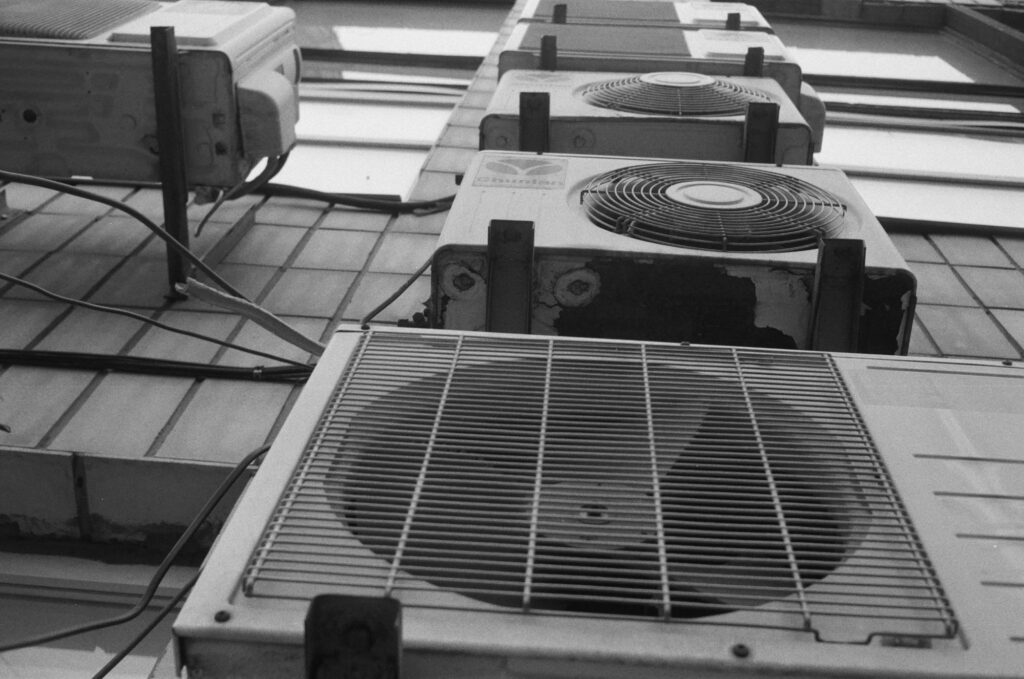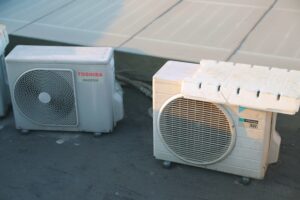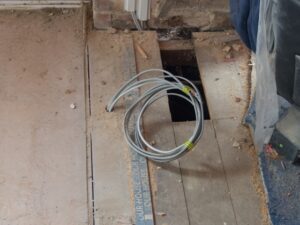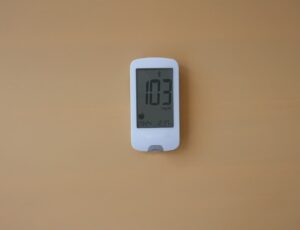When it’s time to replace your AC system, the decision can feel daunting.
You might wonder where to begin and how to choose the right system for your home or office. But don’t worry!
Replacing your AC isn’t just about cooling—it’s about upgrading your comfort and energy efficiency for the long term.
Choosing the right AC system has a huge impact on more than just your home’s temperature. It affects your energy bills, the comfort of your living space, and even your environmental footprint. That’s why it’s important to know when to replace it and what options best fit your needs.
At Excel Mechanical, we make it easy for you. Our team of professionals will guide you through the replacement process with top-tier advice and service. Whether you need a full system replacement or just an upgrade to match your home’s needs, we offer expert installation and solutions tailored to your budget and comfort.
Replacing your AC system can be a game-changer. You’ll enhance the overall comfort of your home, save on your monthly energy bills, enjoy quieter operation, and lower your carbon footprint.
In this blog, we will explore:
- The types of AC systems and which one is right for you
- The signs that indicate it’s time for a replacement
- How to prepare for the installation process and select the right contractor
So, how do you know it’s time to replace your AC system?
Let’s dive into the factors to consider.
Understanding AC Systems
Air conditioning (AC) systems are essential for maintaining comfort in homes and businesses. They come in various types, each suited for different needs. Understanding their components and operation helps you make informed decisions about installation or replacement.
Types of AC Systems
There are various types of AC systems designed to meet different cooling requirements.
- Central AC systems are popular in larger homes, distributing cool air through a network of ducts.
- Ductless mini-split systems are flexible and ideal for homes without ductwork, allowing individual control in different rooms.
- Smaller spaces often benefit from window units and portable air conditioners, which are easy to install.
Each type has unique advantages and considerations, influenced by space, budget, and desired efficiency.
Components of an AC System
AC systems comprise several key components working together to regulate indoor temperature.
- The compressor, often considered the system’s heart, compresses refrigerant and circulates it through the unit.
- The condenser coil releases heat absorbed from indoors.
- Inside, the evaporator coil absorbs heat from your home.
- Fans and blowers move air across the coils and through the ducts or vents.
- Controls and thermostats allow you to set and maintain desired temperatures.
Properly understanding these parts may aid in troubleshooting issues or discussing needs with a professional.
How AC Systems Work
AC systems work by cycling refrigerant through their components, transforming it from liquid to gas. The process begins with the compressor, pumps refrigerant through the condenser coil outside the building.
Here, it releases heat and condenses into a liquid. This liquid refrigerant then travels indoors to the evaporator coil, where it expands, changing back into a gas and absorbing heat inside the space.
Fans blow air over the evaporator coil, cooling it before circulation throughout your home or office.
Reasons to Replace an AC System
Swapping out an old AC system can improve energy efficiency, reduce maintenance headaches, and take advantage of new technology. Upgrading can lead to lower energy bills and a more comfortable home or office environment.
Inefficiency and Age
As air conditioning systems age, their efficiency tends to drop.
An old AC unit may consume more energy to provide the same cooling as it once did. This is especially true for systems over ten years old—newer models often have better energy efficiency ratings. Higher energy costs mean it’s time to consider a replacement.
A new AC unit saves on monthly bills and provides more consistent temperatures. Even minor upgrades can result in noticeable changes in your comfort and the overall system performance.
Frequent Repairs
If you’re frequently calling for repairs, it might be time to consider replacing.
Continual issues with components like the compressor or fan can be costly. Repair costs increase, so investing in a new, reliable system could save money. Repeated breakdowns are not just a financial burden; they also impact comfort and peace of mind.
You deserve a system that works efficiently without constant attention from technicians.
Advancements in Technology
Modern AC systems come with significant improvements and smart technology.
Features like programmable thermostats and energy-efficient compressors can enhance comfort while minimizing electricity usage. Old systems may lack these features and, therefore, efficiency.
Today’s models often use environmentally-friendly refrigerants, unlike older ones that might use phased-out chemicals. These advancements are worthwhile upgrades.
At Excel Mechanical, we excel by staying updated with the latest technology, ensuring that your new system is both efficient and eco-friendly.
Preparing for AC System Replacement
When preparing to replace your AC system, it’s important to consider your specific needs, select the most suitable system, and ensure you work with a qualified contractor. Taking these steps can help ensure a smooth and successful replacement process.
Assessing Your Needs
Before replacing your AC system, evaluate your current and future cooling requirements.
Consider the size of your home and how much cooling power you need. Think about energy efficiency. An efficient system can save on utility bills over time.
Another factor is the climate in your area. Some systems work better in hotter climates, while others are more suitable for milder conditions. Also, consider your budget.
Set a realistic budget reflecting upfront costs and potential savings from an energy-efficient model.
Choosing the Right System
Selecting the right AC system involves understanding different types of air conditioners.
Options include central air units, ductless mini-splits, and window units. Each type has its benefits and limitations.
Central air systems might be more efficient for larger homes. Ductless mini-splits offer flexibility for zoning. Consider the unit’s energy rating, too. Higher ratings often mean better efficiency and greater savings. Choosing a system that matches your home’s size is also important.
An appropriately sized system ensures optimal performance without overworking the unit.
Finding a Qualified Contractor
A reliable contractor is vital for a successful AC system replacement.
Start by seeking recommendations or searching online for professionals with strong reviews. Check that the contractor has the necessary licenses and insurance. This ensures they meet industry standards and protect you from liability in accidents.
When searching for a contractor, our team stands out for our dedication to exceptional quality and value. We have expertise in both residential and commercial HVAC needs and are committed to providing personalized solutions tailored to your specific requirements and budget.
During consultations, ask questions to gauge their experience and competence. A good contractor should offer a clear and detailed estimate and a timeline for the project.
Communicate your expectations clearly to ensure a successful partnership.
The Replacement Process
Switching out your AC system involves several key steps to ensure efficiency and comfort in your home. First, you’ll need to remove the old system, install the new one correctly, and then perform important post-installation checks.
Old System Removal
Removing the old AC system requires planning.
- First, turn off the unit’s power. This prevents accidental electrical mishaps.
- Next, the refrigerant must be handled properly, typically by a certified professional, to avoid environmental damage.
- Disconnect and remove components with care. The outdoor condenser, indoor evaporator coil, and connecting lines must be removed. If you’re doing it yourself, ensure you label any wiring so you can reconnect everything properly later.
- Finally, clear the area around the old unit. This will make installing the new system easier and ensure there are no obstacles or hazards in the way.
Installation of New AC System
Installing a new AC system begins with placing the new outdoor unit.
- Ensure it’s positioned on a stable surface to avoid vibrations and noise
- Next, move to the indoor components. The evaporator coil should be placed within the air handler or furnace.
- Connect the necessary ductwork. Proper connections are key to efficient airflow throughout your home.
- Insulate the system as needed to prevent energy loss.
- Make the electrical connections next. If you handled the removal on your own, follow the labeled wiring. For specific requirements, it’s crucial to refer to the manufacturer’s installation guidelines.
Post-Installation Checks
Once the new system is in place, numerous checks are necessary.
- First, test the system’s functionality by powering it on. Listen for unusual noises that could indicate installation issues.
- Check the airflow from the vents. Ensure it’s consistent with the manufacturer’s specifications.
- Monitor the temperature to verify optimal performance.
Our team prioritizes quality and value, ensuring the system meets your needs and budget. Finally, schedule regular maintenance. This keeps your system running efficiently and extends its lifespan significantly.
Costs and Financing
Replacing an AC system involves understanding its costs and finding ways to manage these expenses. You must consider prices, financing options, and warranty plans offered by various providers.
Estimating Replacement Costs
When estimating replacement costs, consider several factors. These include the size of your home, the type of system, and the installation complexity. Prices can range from a few thousand dollars to much more for larger, high-efficiency units.
A typical cost breakdown may include:
- Unit Price: The cost of the AC unit itself.
- Installation: Labor and installation fees.
- Additional Components: Ductwork, thermostats, or other necessary parts.
It’s wise to get multiple quotes to ensure competitive pricing.
Exploring Financing Options
Finding suitable financing options can make replacing your AC system more manageable.
You might explore personal loans, credit cards, or special financing offers from HVAC providers. Some companies offer installment plans or deferred payments to ease the financial burden.
Look for promotions or discounts available during specific times of the year. Be sure to compare interest rates and terms to find the best deal for your budget.
Understanding Warranties and Service Plans
Warranties and service plans are crucial for protecting your investment.
A good warranty covers major components for a specific period, providing peace of mind. Service plans often include regular maintenance, which helps extend the life of your system.
Evaluate the warranty’s inclusions and any limitations or requirements. Coverage length, parts, and labor costs can vary between manufacturers.
Our service plans and warranties focus on durability and efficiency, ensuring exceptional support and quality for both residential and commercial systems.
Maintenance and Upkeep
Keeping your AC system in top condition involves regular maintenance tasks that you can perform yourself, along with periodic professional evaluations. These actions ensure the system operates efficiently throughout its lifespan.
Regular Scheduled Maintenance
Regular maintenance is key to prolonging the life of your AC system.
Scheduling maintenance every six months helps detect wear and tear early. Professional inspections cover areas such as checking refrigerant levels, cleaning coils, and ensuring electrical components function correctly.
Set reminders for these important visits. They monitor critical components that affect efficiency and longevity, ultimately saving you money on energy bills.
Consistent upkeep also minimizes sudden breakdowns and keeps your home cool and comfortable.
DIY Maintenance Tips
You can perform simple tasks to ensure your AC system runs efficiently.
- First, filters must be replaced or cleaned every one to three months to improve air quality and system performance.
- Dirty filters obstruct airflow, causing your system to work harder than needed.
- Make sure vents are clear of dust and obstructions.
- Check for any visible damage or leaks in the system.
- Keeping the outdoor unit free of debris like leaves and twigs prevents airflow from being blocked.
While some tasks require professional expertise, these DIY tips can significantly impact your system’s efficiency.
Professional Service Contracts
A professional service contract can offer peace of mind for major maintenance tasks.
Excel Mechanical provides comprehensive contracts that cover in-depth inspections, repairs, and system performance evaluations for residential and commercial properties.
With experienced technicians at your service, these contracts ensure that your specific needs and budget are met without compromising quality. Additionally, having a contract means prioritizing emergencies and giving you prompt service when needed.
Consider investing in a contract if you value a hassle-free approach to maintaining your AC system.
Environmental Considerations
When replacing your AC system, it’s crucial to consider how it affects the environment. Considering energy efficiency, refrigerant types, and sustainable practices can help you make better choices for your home and the planet.
Energy Efficiency
Opting for an energy-efficient air conditioning system can significantly reduce your carbon footprint. Modern units with high SEER (Seasonal Energy Efficiency Ratio) ratings use less electricity while providing the same comfort level.
Energy-efficient systems not only lower your utility bills but also contribute to reduced greenhouse gas emissions. Some units may include features like variable speed motors or smart thermostats.
These features help optimize energy use by adjusting output based on your cooling needs, ensuring minimal energy waste.
Refrigerants and Regulations
Refrigerants play a key role in your AC system’s environmental impact.
Older systems often use R-22, a refrigerant that contributes to ozone depletion. New regulations require the use of more environmentally friendly refrigerants like R-410A, which have less impact on the ozone layer and are more energy-efficient.
Understanding these regulations when replacing your system ensures compliance and environmental responsibility.
Sustainability Practices
Implementing sustainable practices in your AC system replacement can further enhance environmental benefits. Recycling old units prevents harmful materials from ending up in landfills. Additionally, choosing systems made from recyclable materials helps reduce waste.
Regular maintenance and timely servicing of your new system also prolong its lifespan and efficiency, minimizing environmental impact. At Excel Mechanical, we prioritize sustainability in our HVAC solutions.
We aim to provide systems that meet comfort needs and align with a responsible environmental approach. This commitment makes us a trusted choice for eco-conscious HVAC replacements.
Frequently Asked Questions
When it comes to replacing your AC system, you probably have a lot of questions. That’s totally normal! After all, it’s an important investment that impacts your comfort and your energy bills. Let’s take a look at some of the most common questions people have about AC replacements, so you can make an informed decision.
What factors contribute to the cost of installing a new air conditioning system in a residential property?
The system’s efficiency rating influences the cost, the complexity of the installation, and any necessary ductwork modifications. Consider selecting a system that meets your energy needs without overspending on features you might not use.
What are the estimated costs for replacing an air conditioning unit in a car?
The cost to replace a car’s AC unit may vary based on the make and model of the vehicle. Typically, the price can range from a few hundred to over a thousand dollars, depending on labor and parts.
What are the economic guidelines that help decide whether to repair or replace a home AC system?
A common guideline is the “5,000 rule.” Multiply the unit’s age by the cost of the repair. If the total exceeds $5,000, replacing the unit might be more cost-effective.
How does the size of a home affect the cost of a new air conditioning unit installation?
Larger homes require systems with more capacity, which can increase costs. It’s important to have a system that suits your home’s size to ensure efficient cooling and cost savings.
What are some cost-effective approaches to upgrading an HVAC system?
Consider energy-efficient models and programmable thermostats. Regular maintenance can also enhance performance and longevity, minimizing expenses over time.
Is it financially sound to replace an air conditioner that is over 20 years old?
Replacing an old unit can be wise due to advances in energy efficiency and the reduced risk of costly repairs. Newer models can offer significant savings on your energy bills.




